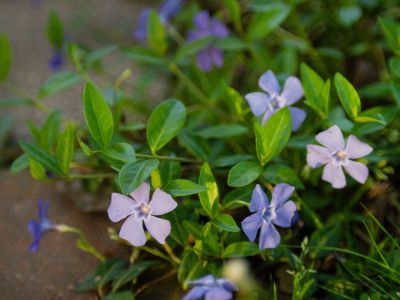What is Vinca?
Vinca vine, or periwinkle, is a flowering groundcover. It came to the U.S. from Europe in the 18th century and quickly took off, becoming popular for its fast growth, pretty flowers, and hands-off maintenance. It even thrives in shady areas, which makes it a popular choice for areas where grass doesn’t grow well. The problem with using periwinkle in your garden is that it can grow too fast and too easily. An invasive species, it outcompetes many native plants and wildflowers. Not only will you face trying to manage the vigorous growth of vinca in your own yard, but it can escape and take over natural areas. You’ll often see periwinkle in disturbed areas, along roads, and in forests.
What to Plant Instead of Vinca
Fortunately, there are plenty of good periwinkle alternatives that will give you attractive groundcover without the risks of an invasive plant. Here are some good vinca vine alternatives to consider for your yard, broken down by sunlight needs:
Full shade – One of the big draws of periwinkle is that it will grow even in the most difficult, shady areas of your lawn. There are other options available though. Try carpet bugleweed, which has pretty, variegated foliage. In warmer USDA zones, including 8 through 11, use peacock ginger for pretty leaves and summer flowers.
Partial shade – Native to most of the eastern U.S., creeping phlox is a great choice for partial shade. It produces stunning color with purple spring flowers. Partridgeberry also does well with some shade and can be grown in zones 4 through 9. It grows very low to the ground and produces white to pink flowers followed by red berries that last through winter.
Full sun – In warmer climates, try star jasmine for sunny areas. This vine also grows well as a creeping groundcover. Creeping juniper will tolerate full sun and can grow in a range of climates. These are low growing conifers that will give you evergreen color year-round.
